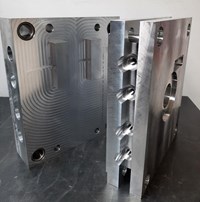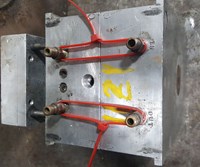All-Digital CMM Automates Mold and Die Inspection
Hexagon’s Maestro coordinate measuring machine offers highly accurate and efficient inspections, handling complex geometries, detailed mold cores, cavities and tight-tolerance components.
Engineered for speed, precision and performance, Hexagon’s all-digital Maestro coordinate measuring machine (CMM) meets the evolving demands of modern manufacturing and delivers quality for the next generation.
The CMM offers faster inspection with no trade-offs – designed and engineered from the ground up to deliver precision while closing productivity gaps and eliminating bottlenecks. It enables intuitive operation for all skill levels through simplified workflows and cloud-powered software. Built for connected facilities with an end-to-end digital architecture, it enables seamless automation integration and scalable upgrade paths.
In the mold and die industry, precision is critical. Shops dealing with injection molds, stamping dies and intricate tooling require highly accurate and efficient CMMs capable of handling complex geometries, detailed mold cores, cavities and tight-tolerance components. The Maestro CMM meets and exceeds these demanding industry requirements by delivering exceptional speed, ease of use, connectivity and scalability.
Maestro excels in speed, which is crucial for competitive mold and die operations. The DSL 100 digital laser scanner rapidly captures detailed, complex surfaces such as mold cores, cavities and parting lines. Its Shine technology ensures precise scanning even on reflective mold surfaces and areas with varying textures and colors, which are commonly encountered in high-gloss automotive molds and detailed precision tooling.
The DST 200 digital tactile scanning probe accurately and efficiently measures intricate features, including fine ribs, thin-walled sections and critical sealing surfaces, which is essential in injection mold and stamping die applications. The rapid sensor exchange boosts inspection speed without compromising precision.
For critical dimensional checks like bore sizes, hole positioning and insert pockets in molds and dies, the DTT digital touch-trigger probe provides rapid and precise single-point measurements, ensuring dimensional accuracy critical to tooling performance.
The Maestro CMM also enhances operator productivity through digital sensor integration. The CMM identifies sensor configurations automatically within its digital twin, simplifying complex measurement routines involving combined tactile and laser scanning inspections. The digital changer rack ensures secure and efficient sensor handling and exchanges, even following manual adjustments, crucial for maintaining consistent accuracy in intricate mold inspections.
Automating mold and die inspection processes with Maestro increases shop efficiency. Integration into automated production environments (such as EDM tool electrode validation) simplifies and accelerates measurement workflows. The Metrology Communication Interface (MCI) provides seamless connectivity with robotic cells and automated tooling systems, reducing human intervention and boosting operational throughput.
The CMM is designed for adaptability, aligning with evolving mold and die industry requirements. Enhanced accuracy demands are easily accommodated via the Accuracy+ upgrade, ensuring consistent high precision. Additionally, integrating advanced capabilities like the DSL 100 laser scanner to handle more complex freeform surface measurements can be implemented effortlessly, enabling Maestroto scale alongside expanding application needs.
As mold and die technology advances, Maestro’s intuitive, connected software environment equips operators with the resources needed to manage growing complexity. In addition, Metrology Mentor supports the creation of robust measurement programs, enabling operators to deliver consistent, reliable results regardless of skill level, ensuring ongoing productivity and excellence in mold and die manufacturing.
Related Content
-
Breaking Down 3D Scanning in Moldmaking
Identifying 3D scanning requirements and implementing the appropriate technology.
-
How To Break Free From CMM Dependency
Moving from CMM to in-process verification requires investment in equipment, processes and people to maintain quality standards.
-
Automating Mold Inspection: Integrating Speed, Precision and Usability Across Complex Workflows
Whether you're verifying an electrode, checking a complex cavity or feeding quality data into a closed-loop workflow, today’s CMM technologies are turning inspection into a competitive advantage, not a bottleneck.

















